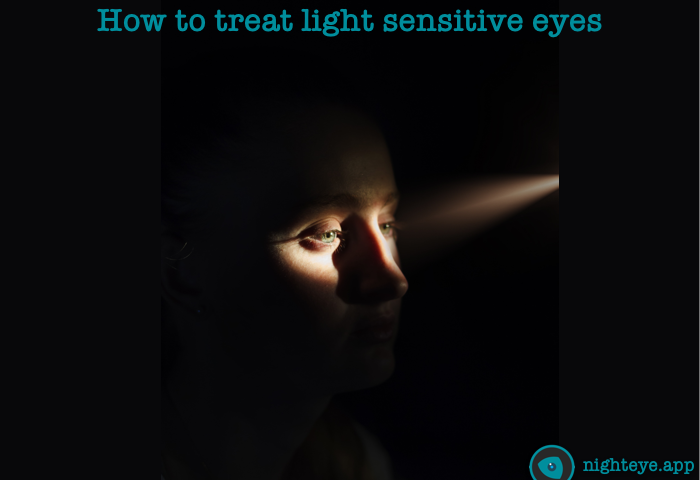
What is photophobia?
Literally translated, photophobia means "fear of light" in German. However, it is usually not a psychological phenomenon as the word suggests; the term is used primarily in connection with physical causes. Eye photophobia is a sensory disorder and is mostly triggered by neurological or eye diseases. Those affected often avoid both daylight and artificial light in closed rooms. Some always wear sunglasses or - if the suffering is high - never leave the house at all. Since such a life is associated with far-reaching restrictions, it is worthwhile to have the cause of the photophobia clarified by a specialist and, if necessary, treated.
What causes photophobia?
Photophobia does not necessarily have to be caused by an eye disease. It can also be a symptom of various diseases that do not directly affect the eyes. This can be a simple viral infection or more serious causes such as meningitis or a tumor. This is another reason why it is important to have the eyes' sensitivity to light examined medically. The third category of causes is external influences on the eyes.
- dry eyes
- Conjunctivitis
- Corneal abrasion or corneal inflammation
- Retinal detachment
- Uveitis (inflammation of the skin of the eyes)
- Iritis (inflammation of the iris)
- Glaucoma (green star)
- Cataract (cataracts)
- Eye surgery not long ago
Other diseases that trigger photophobia include:
- viral infection or inflammation which irritates the eyes
- severe headaches, migraines and chronic fatigue syndromes
- Meningitis (inflammation of the meninges)
- rabies
- botulism
- Tumors in the pituitary gland
External influences that can trigger photophobia are:
- direct UV radiation in the eyes
- Photokeratitis or flashing (small injuries to the cornea as a result of strong sunlight)
- Injuries from foreign objects in the eye
- Contact of the eyes with toxic substances (e.g. cleaning agents)
- improper handling of contact lenses
Symptoms of photophobia
The automatic lid closure protects against too-bright light, which could damage the retina. This mechanism also works for photophobic people, but they also feel uncomfortably blinded by everyday light sources. Symptoms of photophobia include the need to close your eyes or blink. In addition, the eyes often sting and pain. Headaches can also be associated with increased sensitivity to light. Depending on the underlying cause, there are other complaints that point to different diagnoses.
Treatment of photophobia
In order to successfully treat photophobia, the cause must first be determined. The diagnosis is made by the family doctor, ophthalmologist, or neurologist. As soon as the trigger is found, appropriate treatment can begin. For example, if the photophobia is triggered as a side effect by a certain drug, the family doctor could stop the latter and prescribe an alternative drug.People who are particularly light-sensitive by nature can avoid bright sunlight and other light sources by, for example, wearing wide-brimmed hats and more tinted sunglasses with UV protection outdoors. Also, a pair of glasses with photochromic glasses is worth photophobia considering. The glasses darken automatically outdoors and also block almost 100 percent of the sun's UV radiation. Polarized sunglasses help in strong sunlight and reflective environments such as water, sand, or snow. Your glasses offer additional protection against dazzling light reflections. The diagnosis: How does the doctor diagnose an increased sensitivity of the eyes? The doctor will first take an initial medical history. He asks about the exact complaints and finds out whether there are already previous illnesses that could play a role.
The ophthalmologist examines the eyes using a slit lamp. With this special examination device, a clouding of the lens, as it occurs in cataracts, can easily be detected. An opacity of the cornea or vitreous humor is also quickly visible under the slit lamp.
The doctor will probably also check your eyesight. This is usually done with a classic eye test, for example with the help of eye charts or the Amsler grid test. The latter provides information on the presence of a retinal disease at an early stage.
Perimetry (field of view measurement)
Another helpful diagnostic method is perimetry or field of view measurement. During this examination, the ophthalmologist determines whether there are any deficits in visual perception. It measures the limits of the field of vision, i.e. the field of vision, which is perceived by the immobile eyes.This diagnostic measure also includes visual acuity. If the visual field fails, there may be an impairment of the optic nerve or the nerve pathways that transmit the visual center.
This is often the case with glaucoma, but this phenomenon can also occur with retinal detachment (ablatio retinae) or with macular degeneration.
Neurological examinations
If the ophthalmologist does not diagnose an eye disease that is responsible for the light-sensitive eyes, he will probably refer the patient to another specialist, such as a neurologist.
They carry out various diagnostic examination methods in order to find neurological causes of the symptoms. This can include a CT or MRI of the brain, but also an EEG, i.e. the measurement of brain waves.
Handle external factors
If external stimuli are responsible for the increased sensitivity to light, these can be removed or prevented. If your PC is the one bringing sensitivity try adding Night Eye for your computer. Night Eye is a browser extension that enables dark mode on nearly any website. The extension is one of the best ways to help people who are sensitive to light and spend a lot of time in front of the screens. In addition, the extension has a blue light filter, which arguably is one of the best ways to relief the eye strain caused by excessive starring at screens.
Install Dark Mode - Night Eye now
No credit card, no names, nothing is required - install Night Eye on your preferred browser and enjoy it completely for free for 3 months. Subsequently, you can stick with the free Lite version or subscribe for $9 per year. You can see for yourself how this dark mode browser extension can help you fight with eye strains.














